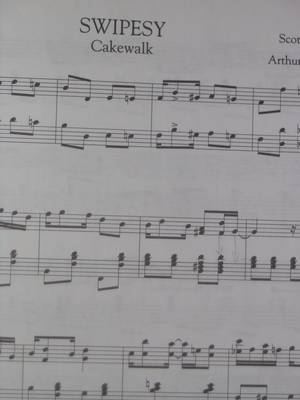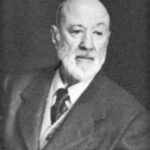February is Black History Month, the perfect time to explore the mystery behind the name of one of famous African American composer Scott Joplin’s musical compositions. Swipesy (sometimes spelled S-w-i-p-s-e-y.). Swipesy, published in 1900, was a collaboration between this famed King of Ragtime and his student Arthur Marshall. More than a century after its debut, the source of its name perplexes the musicologists.
My journey to find the source of the name began not because of Black History Month but as a result of discussions with my son’s piano teacher about the curious name of the piece he was learning.
Scott Joplin’s Fame
Scott Joplin won a posthumous Pulitzer Prize for his opera Treemonisha some 50 years after his 1917 death. Sadly, during his lifetime, Treemonisha never received acclaim, and its lack of public acceptance is often associated with Joplin’s psychological decline in the years preceding his death.
Joplin’s rag The Entertainer is widely known today due to its prominence in the Academy Award winning 1973 movie The Sting. But during his lifetime, Maple Leaf Rag was Joplin’s most celebrated composition.
Composer Scott Joplin’s Life
Many sources place Scott Joplin’s birth on November 24, 1868, but an entry on a mid-1870 census listing his age as 2 years old suggests the possibility that he was born earlier in that year. Like his date of birth, Scott Joplin’s place of birth is obscure. The best information available, recollections of relatives interviewed many years later, suggests that he was born in north Texas.
Scott Joplin’s first access to the piano resulted from his mother’s work cleaning house for a white family who owned a piano. Many sources say he accompanied her to work and taught himself to play while she cleaned. It seems beyond belief that Joplin’s mother, herself a capable piano player, didn’t provide some teaching. However, Joplin biographies don’t credit her, instead espousing the “self-taught wonder” theory. With so little documentation supporting even the critical events in Joplin’s life, it seems like common sense would drive biographers to at least consider that mama might be due some attribution here. But whoever got him started, Joplin alone deserves credit for the reputation he built for himself as a musician.
In his teen years, Scott Joplin met music teacher Julius Weiss. Weiss recognized Joplin’s talent and instructed him in some basic technique. Joplin did not take formal music lessons until 1896, by which time he was already publishing music.
For a brief period in his teen years, Joplin lived in Sedalia, Missouri, a town he would return to again and again, to write some of his most famous works.
Before becoming publicly known as a piano player, Joplin achieved some fame with the cornet. He first worked with a minstrel troupe in 1891 in Texarkana, then moved to Chicago in time for the World’s Fair. Subsequently he returned to Sedalia, Missouri where he played in the Queen City Coronet Band. From there, Joplin started his own band and became an itinerant musician. Eventually Joplin found his way back to Sedalia where he composed his most famous piece Maple Leaf Rag.
While most African American musicians of the day received minimal compensation for their artistic works, Joplin had the foresight to consult with a lawyer before selling his music. The deal negotiated with publisher John Stark uncharacteristically provided that Joplin would receive a one cent royalty on each sale. At first, Maple Leaf Rag, a difficult piece to play, did not sell many copies, but within a few years, its popularity soared and sales of Maple Leaf Rag reached 500,000 copies per year.
Before leaving Sedalia for good, Scott Joplin published two more compositions. The first of these was Ragtime Dance; the second was Swipesy.
Rags and Cakewalks
Rags are a genre of highly syncopated piano compositions. Generally, rags are played in duple meter with a syncopated treble line played over a constant base. The effect is a sense of motion and excitement. This music draws heavily from African American rhythms and folk tunes derived from old slave songs. This music from which the rag was derived is music Joplin would have known well. The rhythms underlying the rag were the rhythms of his life. He was born to a freed slave father and a free born mother who were both musically talented, him on fiddle and her on piano.
Although it shares common characteristics with the rags, Swipesy is generally considered a cakewalk, a musical form that began as dance accompaniment in the 1840s. On southern plantations, slaves dressed up in formal clothing to celebrate the end of the harvest season and did an exaggerated walk to parody the affected manners of the plantation owners. These exaggerated dance-walks often involved competitions, where the dancers would strut and balance items on their heads, with the winner bringing home a cake. Thus, the dances became known as cakewalks.
Eventually, the white plantation owners mimicked the slave dances and cakewalks became a mockery of the slaves; after slavery was abolished, cakewalks continued with free blacks mimicking the whites’ mimicry of them. Whew! Thank goodness Civil Rights legislation lets us all dance together these days, so we don’t have to keep track of who’s mimicking who.
What’s in a Name?
Swipesy, a spritely cakewalk, is shrouded in mystery: where does the name come from and how is it pronounced? The impetus for my researching this was curiosity sparked a piano teacher who in the months preceding Black History Month relayed the story of an accomplished pianist who loved the piece- yet he never played it publicly because he didn’t know how to pronounce its name. That seemed so sad- it’s a wonderful piece and deserves public exposure.
The piano teacher’s brief research uncovered no clues as to the origins of the name. Curiosity gnawed at me until finally I began to research Swipesy to see if I could uncover the mystery of its name. I learned the fascinating history of cakewalks and a lot of details about Scott Joplin’s life and his musical milieu. But the origin of the Swipesy name proved elusive.
Was it a place? I consulted atlases to no avail. If Scott Joplin ever lived in a place named Swipesy, it must have ceased to exist. Then, I came upon an article that mentioned that Joplin did not name his rags. His publisher John Stark named them. That left me delving into the history of John Stark. I found some general information about Stark’s choice of splashy names that would draw attention to the music, but nothing specific about Swipesy.
I was reaching the end of the trail. I scanned a dictionary for the word Swipesy and there I found something close to a breakthrough. “Swipes” is “poor, watery or spoiled beer” or an ale. Just what might have been served in those low-class taverns where Scott Joplin played. Could Swipesy be a reference to what the dancers were drinking? I have not found a definitive answer.
I did come upon two other theories on the website of “Perfesser” Bill Edwards: one theory is that John Stark thought the boy on the cover of the music looked like he just swiped something and the other is that the name might have resulted from two young boys taking swipes at each other outside the music store. Like so many other aspects of Scott Joplin’s life, the meaning of the name of this piece may be forever lost to history. But if a working assumption is made that one of these theories is correct, then the proper pronunciation would be “swipe-sy.” With all three theories in agreement on the pronunciation, let’s hope pianists will now feel free to include this delightful piece included in their public performances. With Black History Month underway, the timing is perfect.






